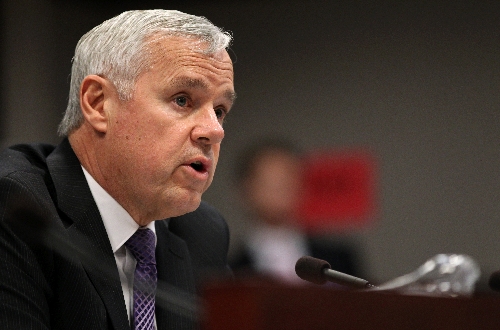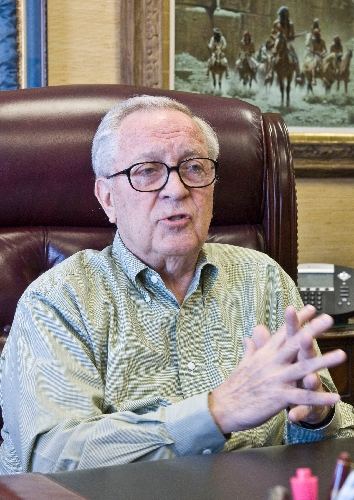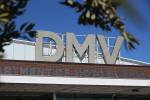Warnings get louder for lack of higher education funding
Way back in 2007, when state budget cuts first started, Nevada's higher education leaders warned of dire consequences.
A proposed 8 percent cut was "horrifying." Programs would be gutted. Students turned away.
Smaller cuts were made, and the system moved on.
Then, as 2008 rolled on, larger cuts were proposed. The rhetoric got louder.
Access would be cut off. The university would lose thousands of students. In the end, the proposed cuts were called a "death warrant" for higher education in Nevada.
Higher education did not die. The colleges and universities are still there, teaching students and employing thousands.
Which is a problem right now, with larger cuts proposed. From the outside, the colleges and universities don't look all that different than they did before the cuts started.
So, did the higher education system's leaders blow things out of proportion? Were they exaggerating? Are they doing the same thing all over again?
Yup, same story, different day, said conservative activist and blogger Chuck Muth.
"Of course they're still exaggerating," he said. "It's pure propaganda designed to get what they want, which is no cuts at all."
In the endless back and forth that is politics, the other side disagrees .
Chancellor Dan Klaich, for example, gave an unusual speech last month that the folks on the right have been having a field day with.
Speaking at a Board of Regents meeting, he essentially said the higher education system had done such a good job covering up its wounds that it seems much healthier than it actually is.
Here's the part that resonated, though. Klaich acknowledged that some higher education leaders may have exaggerated about past budget cuts.
"I think we have been guilty of hyperbole in the past," he said. "Where, you know, we get the first dollar of a cut and we would like you to believe the sky is falling. And here we are a few years later and, lo and behold, the sky is right where it started out. It has not fallen in."
Examples?
Then-Chancellor Jim Rogers wrote a letter to then-Gov. Jim Gibbons in June 2008 opposing a 14 percent cut. "Cuts of this magnitude will be devastating," he wrote. (Klaich said he was not talking about Rogers or anyone specific with his hyperbole comment.)
unlv bankruptcy?
Neal Smatresk, then the provost at UNLV and now its president, said such cuts would be "fatal" to some programs. He said a $30 million cut would force the university to cut 3,000 course sections. It could lose 8,000 or more students.
He was partly right. In the past three years, UNLV's state-funded budget has been cut by $49.6 million. It has not lost a substantial number of students, but it did cut a half-dozen programs last year, and it has cut more than 1,000 class sections. Hiring freezes, layoffs and buyouts have led to more than 500 positions being lost.
The university is even considering recommending financial exigency, the equivalent of declaring bankruptcy.
"We are losing faculty and we are losing our reputation," Smatresk said recently.
At the College of Southern Nevada, President Michael Richards said in 2008 the community college had turned away 383 students in the past three semesters because it was full and could not afford to offer more classes. He said it could be forced to turn away many more.
That turned out to be true. Last year, CSN officials said the school turned away 5,294 students because there was no room. Now, Richards warns that if the proposed cuts go through, a total of 13,000 students might be turned away.
Rogers, retired as chancellor but still active as the owner of Intermountain West Communications, which includes KSNV-TV Channel 3 in Las Vegas, said he was never guilty of exaggeration. And he said he still is not.
The system, Rogers said, could cut 10 percent, or 50 percent, or 98 percent and, yes, it would still be around. "But the only people left would be the janitors."
He said everything he warned about in 2008 and 2009 is coming true.
"The sky is falling in," Rogers said. "I don't understand why everybody doesn't understand that."
And it's going to get worse, he said, if the current budget proposals become reality.
Student fees are expected to increase 10 to 15 percent. Salaries probably will be cut 5 percent.
And each of the eight institutions has presented plans on how it expects to deal with cuts, if they go through.
UNLV officials have said the university will have to eliminate 33 degree programs, lay off more than 300 people, including faculty, and further trim nonessential services, such as campus mail deliveries.
Likewise, CSN officilas are considering closing all of its satellite centers and its Henderson campus. Nevada State College might have to freeze more positions and cut another 130 class sections.
tuition and fee increases
Nonsense, said Muth. They are still exaggerating.
Tuition and fees are extremely low in Nevada, he said. A 13 percent increase would add $30 to the cost of a class at a community college. That is not a "massive" fee increase.
And, he said, some programs on UNLV's list of those it might eliminate should go away.
"Women's studies should have been killed a long time ago," he said.
There are other solutions, too, he said, that aren't being considered. The state college opened nine years ago with the primary mission of educating nurses and teachers. So, Muth asked, why does UNLV still have nursing and teaching programs when it generally costs more to educate someone at a university than at a state college?
And, he said, pay cuts on tenured faculty who make the highest salaries could save money, too. Faculty have already agreed to take up to a 5 percent pay cut if the Legislature mandates it.
While all that is theoretically possible, it is unlikely to make up $162 million -- the difference between the current state-funded higher education budget and Sandoval's proposal for 2013.
Which Rogers thinks makes the point he first started ranting about more than three years ago: Higher education in Nevada is being killed one small cut at a time.
Contact reporter Richard Lake at rlake@reviewjournal.com or 702-383-0307.































